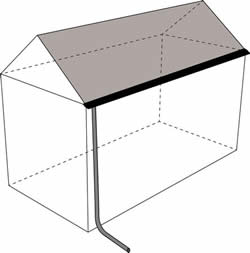Fish & Water

With your location decided and design constraints considered, you can begin sizing your rain garden. Generally, rain gardens are sized as 10 percent of the impervious surface area draining to the garden.
Calculating the Size of Your Rain Garden
The size of a rain garden refers to the volume of water it can hold before the water overflows at the exit point. This volume is described in terms of ponding depth and square feet of surface area (depth × width × length). The more impervious area you want to treat, the bigger your garden needs to be. If you don’t have enough space, you can build multiple rain gardens or build a smaller one and plan for it to overflow more often.
Determining the Drainage Area
Measure the area in square feet of impervious surfaces that will contribute runoff to your rain garden. If you are collecting water from a downspout, measure the length and width of the roof that drains to that downspout (figure 19). Alternatively, you can estimate rooftop area by using Google Earth’s measurement tool (figures 20 and 21) or by estimating the area with a tape measure or by pacing on the ground. Use table 1 to help you think through the impervious surfaces on your property that might flow directly into your rain garden.
- Figure 19. In this image, you can see that half of the rooftop drains to a gutter system leading to one downspout.
- Figure 20. Google Earth was used to outline the portion of a rooftop draining to a proposed rain garden site. Google Earth’s measuring tool will also help you estimate the square footage of a particular portion of the roof.
- Figure 21. Image highlighting the portion of the rooftop that will drain to the rain garden site. The estimated square footage of this portion of the roof is 7,881 square feet.
Sizing Your Rain Garden with Ponding Depth
The size of the rain garden depends on the percolation rates you have and the depth of the rain garden. Ideally, you want a percolation rate of at least 1 inch per hour.
Ponding depth is the depth that water can pond before it flows out of the rain garden. It is measured from the lowest point of the rain garden surface to the elevation of the outlet.
Extra depth may be added below the weir to prevent ponding over the desired depth. You want at least 3 inches of depth for clay soils with drainage rates of less than 1 inch per hour and 3 to 6 inches of depth for sandy soils with greater than 1 inch per hour of drainage.
Because clay soils drain slower, you should make the rain garden shallower to ensure that you won’t have standing water for longer than 48 hours.
For quick and simple calculations, use the 10/20 rule:
- For a 3-inch ponding depth, the rain garden size equals the impervious area to be treated divided by 10.
- For a 6-inch ponding depth, the rain garden size equals the impervious area to be treated divided by 20.
- Example: 30 ft. × 12 ft. (rooftop area) = 360 ft.2 (your impervious rooftop surface area) × .10 = 36 ft.2 of rain garden
Example: The rooftop draining to a proposed rain garden at West Forest Intermediate School in Opelika, Alabama, is 7,881 square feet. We can calculate the size that our rain garden should be by dividing the area by 20 for a 6-inch ponding depth.
7,881 ft.2 ÷ 20 = 394 ft.2 rain garden
The final area of your rain garden does not need to be exact but can be flexible to meet your site needs. The square root of 394 is 19.84, so we can estimate that a 20-foot by 20-foot rain garden might suit your needs.
Compare the result of your soil infiltration test with the information in table 2 to get a good idea of how your soil influences the size of the rain garden. Read on for more specific calculations.
Remember, these are only guidelines. The size of the rain garden also depends on how much money you want to spend, how much room you have in your yard, and how much runoff you want to control. You can reduce the size of your rain garden by as much as 30 percent and still control almost 90 percent of the runoff.
Table 1. Measuring Impervious Surfaces Flowing into the Rain Garden Site
*Remember, you may need to redirect some downspouts to your site if necessary.
Table 2. Suggested Rain Garden Ponding Depth Based on Infiltration Test
Adapted from the Oregon Rain Garden Handbook
Example: At the West Forest rain garden site, the rate of infiltration is roughly 7 inches per hour; therefore, select a 6-inch ponding depth and dig down 9 inches to add a mulch layer.
Remember to account for the addition of mulch when you plan for your finished depth. For example, if you want to add 3 inches of mulch to your final planted garden and it needs to be at least 12 inches deep, you must excavate to a depth of 15 inches from grade.
Remember, safe digging is everyone’s responsibility and is required by law in Alabama. Call 811 at least 2 days in advance to make sure your site will not harm any infrastructure.

Figures 22 and 23. Both rain gardens were excavated to a 9-inch depth, but they have different final ponding depths due to the mulch and soil amendments added.

Figure 24. Rain gardens can be arranged in different shapes while still treating roughly the same amount of stormwater runoff.
Possible Rain Garden Shapes
Is your area 100 square feet? You can do a 10-foot by 10-foot rain garden or a 5-foot by 20-foot rain garden.
Is it 50 square feet? Consider a 5-foot by 10-foot or a 7-foot by 7-foot rain garden.
Example: At West Forest, we planned a 394-square- foot rain garden. The square root of 394 is 19.84, so we could design a roughly 20-foot by 20-foot rain garden or a 14-foot by 28-foot rain garden to meet our needs.
Rain gardens should be a minimum of 5 feet wide to accommodate gentle side slopes that will host plants and minimize soil erosion. The design of your rain garden should work with topography to move water across more vegetation. Make the long sides lay across the slope and have the narrow ends run up and down the slope.
Supply List
- Backhoe, shovels, rakes, tiller, soil tamper
- Wheelbarrow, stakes, string, tarps, spray paint, clean bucket
- Sight level, level, line level, ruler
- Mulch, soil test kit, soil amendments
- Volunteers, snacks, water
My Rain Garden Size Worksheet
Walk through the following steps to calculate the size of your rain garden.
- Calculate total rooftop area.____ ft. × ____ ft. = _________ft.2 rooftop
- Calculate rooftop area that will actually run off to rain garden.You can calculate rooftop area in two ways: (1) use Google Earth’s measuring tool to outline and automatically calculate the square footage of the area of rooftop that drains to your proposed site, or (2) use the following equation to calculate the percentage of total rooftop that runs to the rain garden:Rooftop total × percentage of rooftop that runs off to rain garden(This doesn’t have to be an exact percentage, but try to make it close.)__________ ft.2 (roof area) × _________ (percentage) = ______ ft.2 rooftop to be treatedNote: To calculate percent on a calculator, move the decimal two places to the left and multiply (example: to calculate 25 percent or a number, multiply that number by .25).
- Add any additional impervious area in square feet.Example:___________ ft.2 (rooftop area) + ___________ ft.2 (parking lot area to be treated)= _____ ft.2 total impervious area to be treated
- Set ponding depth to either 3 or 6 inches (remember the 10/20 rule).______ ft.2 rooftop to be treated ÷ _________ (divide by 10 for 3 inches of depth or 20 for 6 inches of depth) = ______________ ft.2 total rain garden areaAt 3 inches, ponding depth = ________ ft.2 total rain garden area (round up or down)At 6 inches, ponding depth = ________ ft.2 total rain garden area (round up or down)Add additional inches to ponding depth if you are adding mulch.If you are going to add mulch to your rain garden, your ponding depth needs to be in addition to that mulch. For example, if ponding depth is 6 inches but you want to add 3 inches of mulch, dig down 9 inches.
-
Now that you have the total area of your rain garden, set the length times width dimensions of your design.
Note: An easy way to get started is to take the square root of your total rain garden area, which will give you the length times width as a square. From there, you can easily adapt your design to fit other shapes.
Length of my rain garden ________
Width of my rain garden ________
Draft drawing of rain garden shape
 This is an excerpt from How to Install a Rain Garden, ANR-2768.
This is an excerpt from How to Install a Rain Garden, ANR-2768.
Laura Bell, Project Coordinator; Eve Brantley, Water Resources Specialist and Professor; Caitlin Sweeney, Assistant Coordinator; and Naomi Pitts, Assistant Coordinator, all with Alabama Extension Water Program at Auburn University




